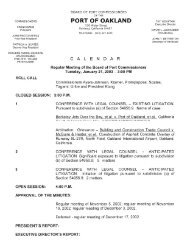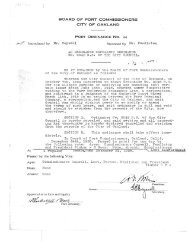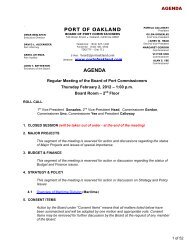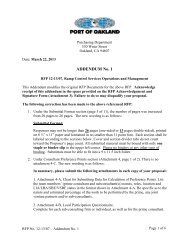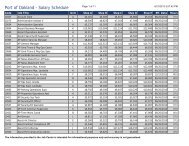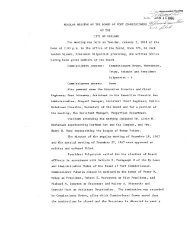Port-Wide Sewer System Management Plan(SSMP) - Port of Oakland
Port-Wide Sewer System Management Plan(SSMP) - Port of Oakland
Port-Wide Sewer System Management Plan(SSMP) - Port of Oakland
Create successful ePaper yourself
Turn your PDF publications into a flip-book with our unique Google optimized e-Paper software.
Chapter 9<br />
SYSTEM EVALUATION AND CAPACITY ASSURANCE PLAN<br />
This chapter provides an evaluation <strong>of</strong> the <strong>Port</strong> <strong>of</strong> <strong>Oakland</strong> (<strong>Port</strong>) sanitary sewer system<br />
facilities, identifies and proposes improvements for deficiencies, identifies design criteria,<br />
and provides a list <strong>of</strong> capital improvement projects (CIP) and schedule for improvements.<br />
9.1 REGULATORY REQUIREMENTS<br />
9.1.1 San Francisco Bay Area RWQCB Requirements<br />
The San Francisco Bay Area Regional Water Quality Control Board (RWQCB) requires the<br />
following:<br />
a. Each wastewater collection system agency shall establish a process to assess<br />
the current and future capacity requirements for the collection system facilities.<br />
b. Each wastewater collection system agency shall prepare and implement a CIP<br />
to provide hydraulic capacity <strong>of</strong> key sewer system elements under peak flow<br />
conditions.<br />
The RWQCB allows for this element to be waived for collection systems that serve a<br />
population <strong>of</strong> 10,000 or less. However, the State Water Resources Control Board (SWRCB)<br />
requirements do not allow for such a waiver. Therefore, the <strong>Port</strong> must prepare a <strong>Port</strong><br />
specific <strong>System</strong> Evaluation and Capacity Assurance <strong>Plan</strong> (SECAP).<br />
9.1.2 SWRCB Requirements<br />
State General Waste Discharge Requirements Order No. 2006-0003 (GWDRs), issued by<br />
the SWRCB, requires that the <strong>Port</strong> prepare and implement a CIP that will provide hydraulic<br />
capacity for peak dry weather flows as well as the appropriate design storm or wet weather<br />
event. The <strong>Sewer</strong> <strong>System</strong> <strong>Management</strong> <strong>Plan</strong> (<strong>SSMP</strong>) must address, at a minimum, the<br />
following:<br />
a. Evaluation. Actions needed to evaluate those portions <strong>of</strong> the sanitary sewer<br />
system that are experiencing or contributing to a sanitary sewer overflow (SSO)<br />
discharge caused by hydraulic deficiency. The evaluation must provide<br />
estimates <strong>of</strong> peak flows (including flows from SSOs that escape from the<br />
system) associated with conditions similar to those causing overflow events,<br />
estimates <strong>of</strong> the capacity <strong>of</strong> key system components, hydraulic deficiencies<br />
(including components <strong>of</strong> the system with limiting capacity) and the major<br />
sources that contribute to the peak flows associated with overflow events;<br />
b. Design Criteria. Where design criteria do not exist or are deficient, undertake<br />
the evaluation identified in (a) above to establish appropriate design criteria;<br />
c. Capacity Enhancement Measures. The steps needed to establish a shortand<br />
long-term CIP to address identified hydraulic deficiencies, including<br />
prioritization, alternatives analysis, and schedules. The CIP may include<br />
increases in pipe size, infiltration and inflow (I/I) reduction programs, increases<br />
May 2010 9-1<br />
pw://Carollo/Documents/Client/CA/<strong>Port</strong> <strong>of</strong> <strong>Oakland</strong>/8239A00/Deliverables/Ch09 (FinalA)



